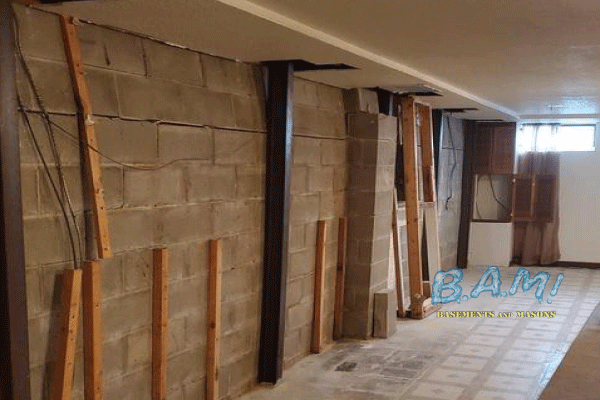Unknown Facts About Best Basement Waterproofing
Unknown Facts About Best Basement Waterproofing
Blog Article
Things about Best Basement Waterproofing
Table of Contents10 Simple Techniques For Best Basement WaterproofingThe smart Trick of Best Basement Waterproofing That Nobody is DiscussingGetting The Best Basement Waterproofing To WorkThe 4-Minute Rule for Best Basement WaterproofingGetting The Best Basement Waterproofing To Work
AdvantaClean's trained specialists and technicians will locate the water source. If wall or piece fractures are present, we will inject polyurethane and epoxies right into the splits and seal the compromise, stopping more wetness from entering.
If there's condensation on the outside of the foil, you have high moisture in your basement. If the aluminum foil has condensation on the within surface (following to the wall surface), the dirt around your house might be naturally damp from a high water table or inadequate soil drainage.
You can waterproof simply your interior wall surfaces, which might solve the issue. Or you can waterproof your exterior wall surfaces, which is a much better wager however more expensive. Here's the scoop on the different kinds: These thick finishes are cement-like. Once they dry, they stick permanently to concrete and masonry wall surfaces (Best Basement Waterproofing).
The Facts About Best Basement Waterproofing Uncovered
Concrete water-proof coatings can not be applied to formerly painted surfaces; check the label. Known as densifiers, they are suitable just for walls that haven't been repainted or secured.
You clean, roll, or spray it on much more thickly one gallon covers simply 75 square feet, not the 300 square feet normal with conventional paint. Water resistant paint is fine for DIY application. You can apply it over painted surfaces, and paint over it once it's healed (one gallon prices $37).
It can set you back $10,000 to $15,000, relying on the work required. Outside waterproofing entails excavating all over your house fully depth of the structure walls, after that mounting a water-proof finishing or membrane layer covered by drainage panels. The panels give an easy course for water to flow down to an external French drain at the bottom of your structure.
A basement without waterproofing is kind of like that. Your basement does not want to go with a rainstorm without appropriate protection just as much as you don't desire to.
Getting The Best Basement Waterproofing To Work
But if you've done your research, you would certainly recognize there are 2 kinds of waterproofing: exterior and interior. It can get puzzling what they both mean, which one's a better investment, and what will really maintain the water out. Don't stress, we created this blog to quickly define both methods for you and talk about the pros and cons of each.
Exterior waterproofing is a waterproofing method that entails securing your home from the exterior. It's kind of like a moat around a castle. It involves excavating a trench around your whole residence down to the foundation (regarding 8 to 10 feet down). The structure walls are then cleaned up, secured, and covered with a water resistant membrane or sealant.
The 5-Second Trick For Best Basement Waterproofing
It's a much more engaged procedure that requires digging up your lawn, which is expensive and taxing. Outside waterproofing involves removing whatever bordering your home, including porches, driveways, walkways, landscaping, a/c devices, decks, and so forth. If any one of the job was done improperly and water is still entering your cellar, there isn't much you can do to correct or fix it.
Interior cellar waterproofing entails waterproofing from the within. Any water that leaks into your cellar is redirected before it touches your flooring. It's sort of like putting on a raincoat under your garments. It involves two things: a water drainage track and a sump pump. It works by sealing the within your basement walls and floors so water that tries to go into is channeled out through a sump pump.
It's a reliable method to water resistant your cellar look at this site - Best Basement Waterproofing. The disadvantage of interior cellar waterproofing mostly involves the installment process. This method requires kept items, furnishings, and built-in shelving or cabinets to be moved from touching dig this the basement walls. And during installation, your basement can't be used. The most significant distinction in between the two methods is this: Exterior waterproofing is a preventative solution and interior waterproofing is a restorative option.
Best Basement Waterproofing Things To Know Before You Get This
In final thought, outside and interior cellar waterproofing are both reliable techniques of shielding your home from water damages. Exterior waterproofing develops a barrier that stops water from entering your home, while interior waterproofing redirects water that does enter your home. And it is essential to note that exterior waterproofing is an expensive and turbulent installation procedure when contrasted to interior waterproofing.
Whichever approach you pick, make sure you select a reliable and credible specialist for the work. If you have any inquiries about cellar waterproofing, please reach out to us.
You can complete our form below, start a conversation in the lower right-hand corner, or call us at 1-800-827-0702.
Report this page